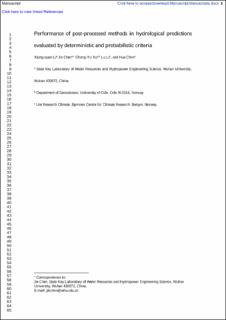| dc.description.abstract | Meteorological Ensemble Streamflow Prediction (ESP), which uses Ensemble Weather forecasts (EWFs) to drive hydrological models, is a useful methodology for extending forecast periods and to provide valuable uncertainty information to improve the operation of future water resources. However, raw EWFs are usually biased and under-dispersive and so cannot be directly used in ESP, leading to the development of several post-processing methods. The performance of these methods needs to be evaluated/compared in building ESP based on deterministic and probabilistic criteria. In addition, likely influencing factors also need to be identified. This study evaluated the performance of four state-of-the-art methods: the Generator-based Post-Processing (GPP) method, Extended Logistic Regression (ExLR), Bayesian Model Averaging (BMA) and Affine Kernel Dressing (AKD), using a simple bias correction (BC) method as a benchmark. The evaluation was carried out over four watersheds with different basin areas in the humid region of central-south China based on the weather reforecasts from the Global Ensemble Forecasting System (GEFS). The results show that the performance of the post-processing methods varies with the forecast variable (precipitation, or air temperature or streamflow), but all of them outperform the BC and GEFS. For the four post-processing methods, the advantage of the generator-based methods (GPP and ExLR) lies in their probabilistic performance, which outperforms the distribution-based methods (BMA and AKD) by about 10% in precipitation forecasts and about 20% in streamflow forecasts, while the distribution-based methods (BMA and AKD) are better at their deterministic performance for precipitation forecasts, with a benefit of about 15%. Meanwhile, the post-processing methods generally perform better for precipitation and streamflow forecasts, but worse for air temperature forecasts for a bigger basin compared to the distribution-based methods. The results of this study emphasize the importance of considering the uncertainty of post-processing methods in ESP. | |
